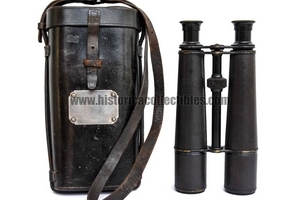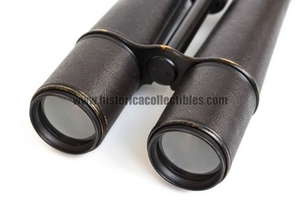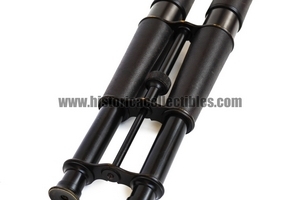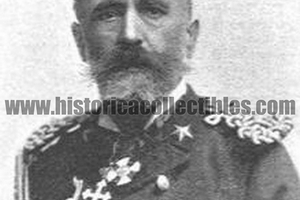Refraction or Galilean Binoculars 12x "Ing. Angelo Salmoiraghi Milano", C.F. Giuseppe PALUMBO, circa 1878
Refraction or Galilean 12x binoculars, produced by "Ing. Angelo Salmoiraghi Milano" around 1878, belonged to the Captain of Frigate 1st class of the Royal Italian Navy, Giuseppe Palumbo, from 1878 to 1883, the year in which he was promoted Vessel and period within which he was Commander of the Cariddi screw gunboat, a ship destined for the Levant during the Russo-Turkish war, for the protection of Italian citizens. Palumbo, continued to operate in the Aegean also with the next ship that commanded, from 15 March 1880, the Avviso a propeller Agostino Barbarigo, furthermore he was promoted on 1 March 1882, commander of the second class warship, Vettor Pisani, with which from the following 20 April he made a long voyage of circumnavigation of the globe which lasted over three years, which gave him great fame.
During the cruise Palumbo carried out diplomatic missions to various Latin American states. He had hydrographic surveys carried out and favored the activity of some scholars embarked for the occasion in order to carry out research in the botanical and zoological fields.
What makes these beautifully preserved binoculars rare is that they were the first model to be built by Eng. Salmoiraghi following the dissolution of the previous company called Salmoiraghi - Rizzi e C. Milano, which saw its activity between 1873 and 1877.
The binoculars come complete with their original leather case, on which a silver plate is affixed with the C.F. grade. (Fregate Captain), the name Giuseppe Palumbo, the knot and the Savoy crown, which bears features of the typical crown of the Umbertino period (Umberto I King of Italy, from 1878 to 1900).
Giuseppe Palumbo was born in Naples on 31 December 1840 to Antonio, (Higher Officer of the Bourbon Navy) and Carlotta Amendola.
Following in his father's footsteps, on 1 September 1851 Giuseppe entered the Royal Marine Academy and was appointed ensign on 27 April 1856. His first embarkation took place on the second-rank wheeled pyro-frigate Tancredi, on which the 11 May 1857 remaining there until 8 January 1858. In the following months it was assigned to other Bourbon ships which operated mainly in the Tyrrhenian Sea and in the central Mediterranean and on 26 October 1859 it was promoted to ensign.
Following the expedition of the Thousand in 1860 he left the Navy of the Kingdom of the Two Sicilies and joined the Garibaldini; with the modern first-rank screw frigate Garibaldi was able to participate in the siege of the Bourbon strongholds of Gaeta and Messina obtaining the silver medal for military valor.
On 16 September 1861, having taken service in the Royal Italian Navy, while he was embarked on the second-rank corvette Stromboli he was appointed second-class lieutenant and, after having served on other ships, on 9 January 1865 he was assigned to the first-order piro-frigate Prince Umberto propeller.
This unit had been chosen to carry out a training campaign for Navy school goers which even included stops in South American ports facing the Pacific and, to reach them, it had to cross the Strait of Magellan, being the first ship of the Regia Marina to overcome that dangerous stretch of sea.
Prince Umberto with Palumbo returned to Italy in June 1866, in time to take part in the third war of independence by operating in the Adriatic. He was present at the battle of Lissa on 20 July 1866 and distinguished himself in the rescue of the shipwrecked of the first rank armored frigate Re d'Italia.
On 1 August 1866 Palumbo was promoted to first class lieutenant and in September, again on board the Principe Umberto, he participated in the repression of the uprisings that broke out in Sicily.
After other embarkations, on April 1, 1873 he became second class frigate captain and first class on February 1, 1878, obtaining command of the propeller gunboat Cariddi which was destined for the Levant during the period of the Russo-Turkish war for the protection of Italian citizens. Palumbo continued to operate in the Aegean also with the next vessel that he commanded from 15 March 1880, the screw-driven notice Agostino Barbarigo.
On 1 March 1882 he became commander of the second-class warship Vettor Pisani, with which from the following 20 April he made a long voyage of circumnavigation of the globe which lasted over three years which gave him great fame. During the cruise Palumbo carried out diplomatic missions to various Latin American states, had hydrographic surveys carried out and favored the activity of some scholars embarked for the occasion in order to carry out research in the botanical and zoological fields.
During that trip, on 1 September 1883 Palumbo was promoted to captain and, upon returning to Italy, on 17 December 1885 he became chief of staff of the command in chief of the permanent squadron.
On January 2, 1886 he married Maria Antonietta Florio, who bore him a son named Domenico.
On 1 July 1887 he was appointed chief of staff of the commander of the Naval Training Division and on the following 11 October he obtained command of the transport America with which he contributed to the transfer of the Italian expeditionary force to Massawa in Eritrea.
After other assignments, on 1 January 1891 he was promoted to rear admiral and on the following 11 February he was designated senior commander of the Royal Crew Corps, a position he left in January 1893 when he was appointed Undersecretary of State for the Navy in the first Giolitti government. When the ministerial team fell, on 1 January 1894 he became head of the Royal Naval Academy of Livorno, to then obtain, on 16 January 1895, the position of military maritime commander of the Maddalena.
On 9 April 1896 he was promoted to vice admiral and on the same day he again became undersecretary of state for the Navy in Rudinì's second government; on June 29, 1898, with the installation of the first Pelloux ministry, he was appointed Minister of the Navy. In this capacity he tried to allocate funds to the construction of large ships and proved against the construction of underwater boats, as the French Navy was doing instead.
Leaving office on May 14, 1899, on the following June 1 Palumbo became commander in chief of the third maritime department of Venice, then, from May 1, 1900, of the second maritime department of Naples.
On 1 May 1901 he embarked on the battleship Lepanto as head of the Mediterranean Naval Force, at the time the most powerful team in the Royal Navy, and then transferred the following 23 October to the battleship Sicilia maintaining the same role. During that period he carried out some important exercises and a cruise along the coasts of Tripolitania and Cyrenaica, and carried out a mission in Istanbul.
On 1 March 1903 he became commander-in-chief of the first maritime department and of the square of La Spezia for about four and a half months and then assumed the role of president of the Superior Council of the Navy.
On 4 March 1904 he was appointed senator, after having been elected twice as deputy in the college of Castellammare di Stabia between 1897 and 1902. On 21 July 1904 he became responsible for the third maritime department of Venice for the second time until 31 December 1905 The next day he was placed in an auxiliary service position due to age and enrolled in the Naval Reserve.
He died in Naples on 16 February 1913.
Salmoiraghi was a company resulting from the experience that Angelo Salmoiraghi acquired, after graduating from the Milan Polytechnic, in the Filotecnica, founded in 1865, under the guidance of the founder Ignazio Porro. In Filotecnica, Eng. Salmoiraghi held positions of manager until acquiring the property in 1873, transforming the name into „Salmoiraghi, Rizzi e C.“ for the production of optical and topographical instruments. In 1877 the company dissolved and Angelo Salmoiraghi continued the business alone with a new company called Filotecnica Salmoiraghi. At the end of the century he had excellent collaborations: above all that of Francesco Koristka, improving the offer of optical and precision instruments. Under his guidance, the company developed considerably, until it acquired a leading role among the manufacturers of optical and precision instruments, the Regia Aeronautica and the Regia Marina.






